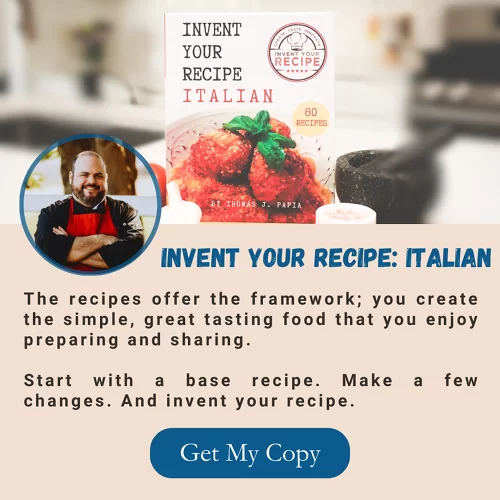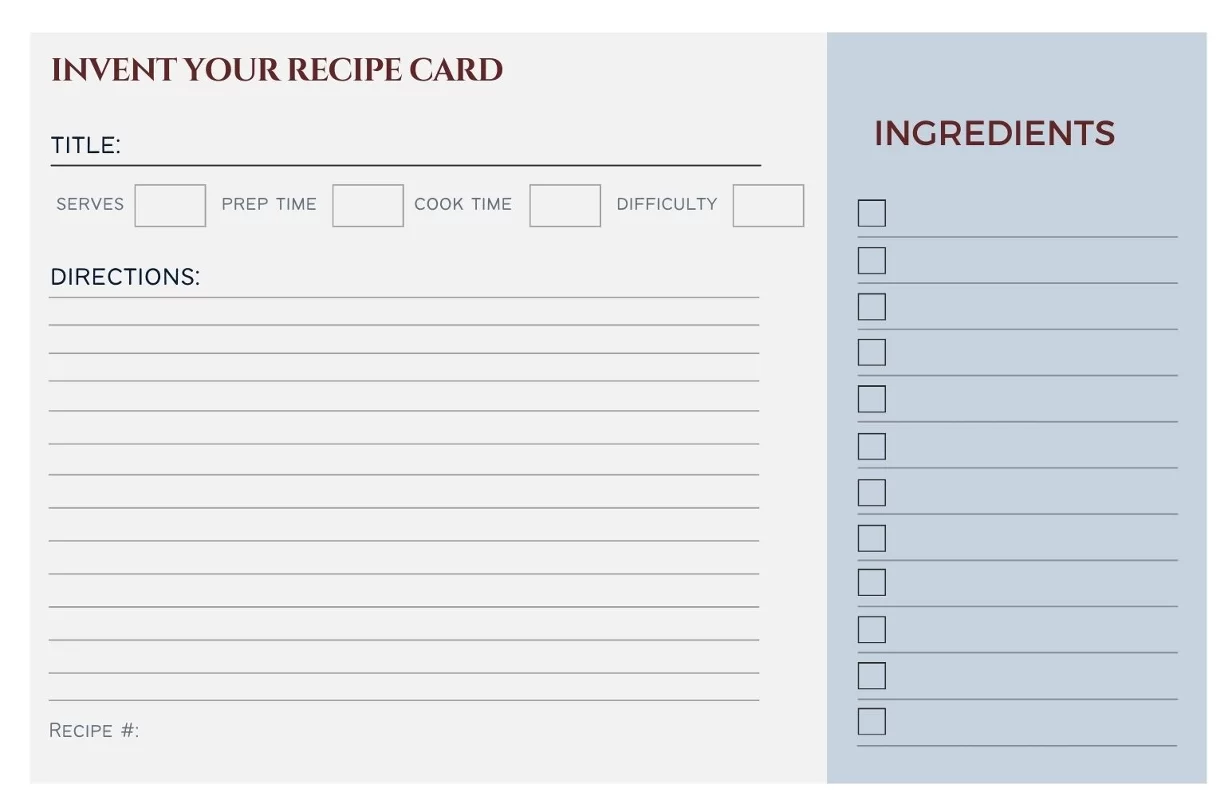How to invent a recipe? You can use the word create, make, put together, or even prepare. But I like to use the work invent. It sounds more scientific, more technical, which to me is comfortable.
I am analytical and technical in nature, so I invent my recipes, but you can use whichever word you like. After all, it is about enjoying the process and making yourself some great tasting food, without being overwhelmed.
Are you looking to write an original recipe, create your own recipes, or to develop and write a recipe book? If so, you have come to the right place. This post will walk you through my process to create custom recipes.
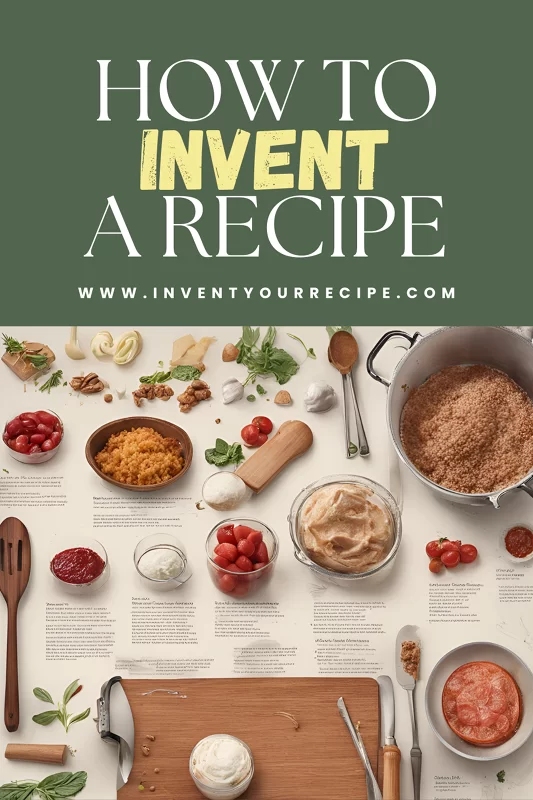
Table of Contents
How To Invent A Recipe: Where To Begin?
We are going to start with your palate, because first and foremost, you are the cook and need to like what you make. Writing down everything you eat, foods you like, and foods you dislike is a great starting point. I encourage you to write all the ingredients down (we will walk through this together below). Do not just make a mental list because you will be drawing inspiration from this list and need to see it.
We will also write down a list of cooking methods you are familiar with and maybe some you want to try.
What Do You Eat?
Let’s walk through some categories of food so you can write down ingredients for each category. Use a notebook to record your lists.
Meat, Poultry, Seafood, & Shellfish
Write down a list of your favorite non-vegetarian proteins to eat. This includes meat (beef, pork, lamb), poultry, seafood, and shellfish. As an example, here are some of my favorites:
- Boneless chicken breasts
- Boneless pork loin or chops
- Eggs
- Sirloin Steak
- NY Strip Steak
- Ground Beef
- Ground Turkey
- Italian Sausage
- Shrimp
- Salmon
Write down everything you like. Do not limit yourself to what you think you can cook, or what you cook now. Write down all the non-vegetarian proteins you enjoy eating. My full list of likes is much longer, but I wanted to provide a short example to get you thinking.
Vegetables
Write down a list of your favorite vegetables to eat. As an example, here are some of my favorites:
- Zucchini
- Green Beans
- Eggplant
- Tomatoes
- Broccoli
- Cabbage
- Lettuce
- Spinach
- Onions
- Garlic
Write down everything you like. Do not limit yourself to what you think you can cook, or what you cook now. Write down all of the vegetables you enjoy eating. My full list of vegetable is much, much, longer. I am an avid gardener and I grow a lot of vegetables throughout the year. Needless to say, I like and eat a lot of vegetables. But I wanted to provide a short list of examples to get you thinking about vegetables.
Fruits
Write down a list of all the fruits you like. As an example, here are some of my favorites:
- Apples
- Pears
- Strawberries
- Cantaloupe
- Pineapple
- Bananas
- Peaches
- Grapes
- Figs
My full list of fruits is longer. But I wanted to provide a short list of examples to get you thinking about fruits.
Grains/Pasta, Nuts, Seeds, and Legumes
Write down a list of all the grains/pasta, nuts, seeds, and legumes you enjoy. As an example, here are some of my favorites:
- Quinoa
- Brown rice
- Bulgar wheat
- Einkorn pasta
- Whole wheat pasta
- Almonds
- Hazelnuts
- Pistachios
- Flax seed
- Sunflower seeds
- Garbanzo beans
- Cannellini beans
- Lentils
- Peas
My full list of grains/pasta, nuts, seeds, and legumes is longer. But I wanted to provide a short list of examples to get you thinking. Take your time here, this is a broad category of foods. Use online resources to help you think about foods that fit into these categories. Then pick the ones you like to include in your list.
By now you have a solid foundation of base ingredients to build a meal. We are just missing the flavor. Let’s get into the herbs, spices, and condiments.
Herbs, Spices, and Condiments
Write down a list of all the herbs, spices, and condiments you enjoy. As an example, here are some of my favorites:
- Oregano
- Basil
- Thyme
- Ground Black Pepper
- Sea Salt
- Garlic Powder
- Onion Powder
- Paprika
- Chili Powder
- Ginger
- Mustard
- Balsamic Vinegar
- Olive Oil
- Coconut Oil
- Avovado Oil
- Butter
Again, my fill list of this category is much longer. But I wanted to provide a short list of examples to get you thinking about herbs, spices, and condiments. Take your time here, this is a broad category of foods. Use online resources to help you think about foods that fit into these categories. Then pick the ones you like to include in your list.
Cooking Methods
Write down a list of all the cooking methods you are familiar with. These can be methods you have mastered, some you want to try, or some that you have tried before but want to do more of. As an example, here are some of my favorites:
- Grill
- Roast
- Pan Fry
- Stir Fry
- Saute
- Sear
- Boil
- Bake
There are more cooking methods, but I have listed a few common ones here. I encourage you to use online resources to understand cooking methods and to help determine which ones you know how to do or that you have done before.

Creating a Base Recipe:
The next step for how to invent a recipe is to look through the list of ingredients you just made and pull some out to make a base recipe. A base recipe is key to building a solid foundation to work from. If you have the base of the recipe in good order you can begin to add a bit of this, or try a bit of that, as you refine the flavor of the recipe.
My cooking style is dynamic. I like to change up recipes all the time, thus the name “Invent Your Recipe” for this food blog. However, I am always working from a tried-and-true base recipe.
Over the years I have developed a catalog of base recipes I can draw from. I call this my “starting lineup” of recipes. If you can get to a place where you have 5-7 base recipes in your starting lineup, you will be able to invent countless recipe combinations to feed your mind, body, and soul.
The base recipes are key to my cooking success as a busy Dad of two who cooks homemade dinners 6-7 times a week. If I have an especially hectic day I can easily go to a base recipe and add whatever else I have in the pantry to make something tasty and nutritious for my family.
The Blueprint to A Base Recipe:
To continue the building analogy, let us now discuss and layout the blueprint for a successful base recipe. We can break the recipe into categories using the sections of ingredients we listed above .

From here we can add in the details of the base recipe from the ingredients you wrote down. As an example, I filled in the categories for one of my base recipes.
- Protein: Boneless Chicken Breasts
- Vegetables/Fruits: Tomatoes
- Grains/Pasta/Nuts/Seeds/Legumes: Cannellini Beans
- Herbs/Spices/Condiments: Salt, Ground Black Pepper, Oregano, Garlic, Olive Oil
- Cooking Method: Sauté in Skillet
This base recipe is Chicken with Cannellini Beans and I use it often to put together different combinations of dishes. Sometimes I change the vegetables, or I add pasta, and other times I mix up the herbs and spices. The beauty of this system is that with the base recipe you always have a strong starting point and point of reference.
I want you to take some time and come up with 2-3 base recipes using the list of ingredients and cooking methods you wrote down. Don’t worry about all the details of the recipe, just fill in the base recipe categories like I did in the example. We will fill in the details a bit later.
If you have more than 3 base recipe ideas that is great! Write down as many as you feel comfortable with cooking. However, do not feel like you need to come up with a full starting lineup of recipes. Start with 2-3 base recipes to get comfortable with the process of creating recipes.
How to Write a Recipe:
Up to this point we have identified a list of ingredients, cooking methods, and 2-3 base recipes. Now it is on to the details.
A good recipe is clear, as concise as possible, and sometimes offers specifics such as smell, sound, and appearance. It all depends on how complicated the cooking instructions are or if the ingredients or cooking method is unique.
I aim to create simple, repeatable recipes, with the fewest ingredients possible, without sacrificing flavor and enjoyment. I know that was a mouthful, but it is my approach to taking a base recipe and filling in the details. This method is straight-forward and I fine it to be less stressful than creating very intricate and detailed recipes that are difficult to remember.
For example, here is the recipe card for the Chicken with Zucchini and Beans recipe I developed from the Chicken with Cannellini Beans base recipe.
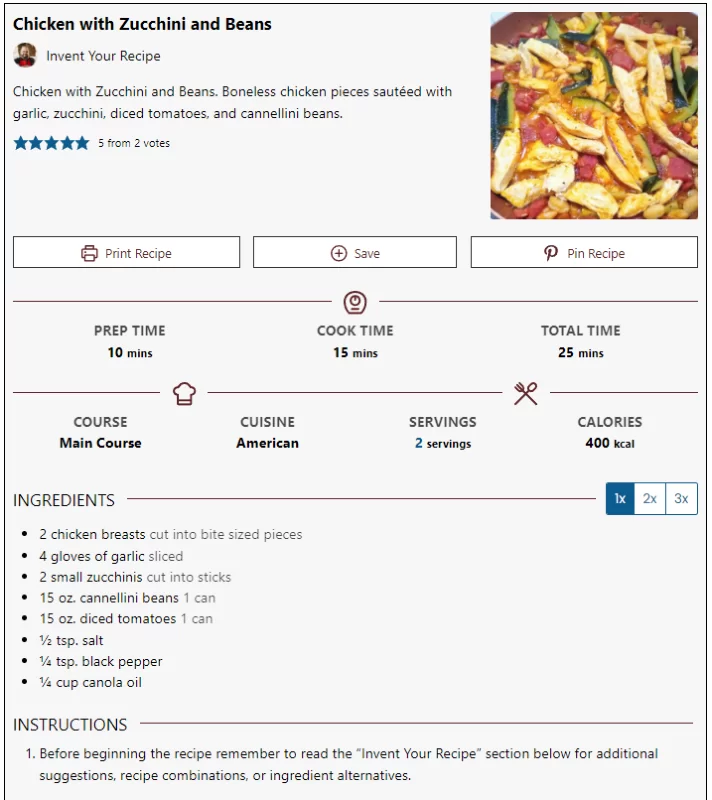
As you can see from the recipe card, I added zucchini to the base recipe, removed the oregano, and used canola oil instead of olive oil. It is that simple. Three small changes and you have a new recipe.
Have a look through my Chicken with Cannellini Beans recipe series to see how I have changed the base recipe to create 5 different recipes.
Sections Of A Recipe:
Recipes can be written any way that you like. Maybe a catchy title is not important to you, or nutritional information is something you do not want to research, or maybe you do not time your steps. Either way, recipe writing is personal, so find you style and get to writing.
You can purchase recipe templates that are fillable. I have a fillable recipe card you can download and use over and over. You can also just use a notebook and then create your own digital version of your recipes later.
For my own personal recipes I do not list any nutritional information or have very detailed time measurements. I cook by feel, smell, and sound (that is a whole other topic entirely, lol). So precise time and ingredient measurements do not always apply.
I encourage you to start with the categories I listed below and then refine your style from there.
Title:
Something memberable, catchy or funny. Or just straight to the point.
“Fire in the Hole Beans and Chicken” or “Chicken with Cannellini Beans”
Servings:
This will depend on your audience. Most recipes are written for 2 to 4 people or servings. I recommend you start there and can augment the size if needed. I like to write all my recipes for 2 servings, then increase as needed.
Time:
This will depend on the ingredients and cooking method. As a starting point, I recommend you research some common cooking time bases on the ingredients in your base recipe. I would then list out the ingredients by the time it would take to cook each ingredient by itself. Whichever ingredient takes the longest to cook is where I would begin developing the steps around.
For instance, in my base recipe, I am using boneless chicken breasts which takes the longest to prepare as an individual ingredient. It takes about 4 minutes a side when sauteing (8 minutes total).
From that time estimate I would layer in the other ingredients and their cooking times. Back to my example I am using a can or cannellini beans and diced tomatoes, which are both prepared already, so they just need to be incorporated and the dish finished. To finish the dish I would add a few minutes of cooking time to heat the beans and tomatoes (3 minutes), plus cooking time to combine (2 minutes), but not a significant increase in time because these ingredients are already “cooked”.
The time estimate for this dish would be about 12-15 minutes of cooking time (does not include preparation time). But this is just a guideline, the size of the chicken, the temperature of the stove, and the skillet used can all changed the exact time.
This may see, complicated and overwhelming, but as you cook more you get a sense of how your environment affects cooking times. I recommend you start with common cooking times and adjust for your kitchen.
Ingredients:
You can list ingredients any way you like, again, this is your recipe. The most common ways to list ingredients are by size/volume/weight, or by the order they are used in the recipe. My favorite method is the latter.
I find that listing the ingredients in the order they are to be used the most helpful and efficient way to list the ingredients.
When listing the ingredients include the measurement of the ingredient, ingredient name, and any preparation instructions. For instance,
- 2 boneless chicken breasts, cut into bit-sized pieces
- 4 garlic cloves, sliced
- 1 can diced tomatoes, 15-16 ounces
Again, research some common ways to list ingredients and reference some other recipes you have cooked or found online.
Instructions:
The steps of the recipe can be as simplistic or detailed as you would like. If you are a beginner cook you should probably write down as many details as possible with notes to aid in the cooking process.
For example, from my base recipe you could write, “when sautéing the chicken, add the chicken to the hot oil and cook for 4 minutes. You want the chicken to be golden brown before flipping over. If needed, add some additional time to achieve the desired color. Then flip and repeat the same process on the other side of the chicken.”
However, if you are familiar with what sautéing looks like, you can just say “sauté on both sides for 4 minutes”. Understanding full well that 4 minutes is a guideline, and it could mean 5 minutes or longer depending.
I always recommend writing as much detail as possible because you may cook something once, write it down, and not cook it again for months. Having more detail will ensure a closer result the next time. Also, if someone else would like to make your recipe, they will need all the little details. Unless you don’t want them to know the secretes!!
Notes:
I treat this section as an ingredient alternatives list. I like to list all the different ways I can change the recipe, or ways that I have changes the recipe in the past. I have a handy list of ingredient alternatives that you can reference for this section. I have compiled this list from the many years of creating different recipe combinations. This list is also included in my cookbook!
This section is also good for suggestions on different cooking methods, how to store the dish, how to re-heat the dish, or as a catch-all for any additional information you would like to share.
For instance, in some of my personal family recipes I needed to reference that my Nonna would use a glass drinking cup as her “cup” measurement, which equated to 1 ¼ cups in dry measurement.
Nutrition:
Again, this section is optional, however, if you would like to list out the calories or other nutritional information you can do so here. You can be as detailed as you would like. There are websites that can help you look up nutritional information of ingredients. You can use them to compile a list of everything.
Testing Your Recipe
They recipe has been created, now it is time to test it. So, buckle down, have fun, and cook away.
As you go through the recipe take notes on what worked, what didn’t work, what you would change, and what you would leave the same.
Don’t worry to much about the outcome of the dish the first time through. Focus more on the process, the feel of the dish, the complexity of the dish. Would it be something you would like to cook again? Was it to difficult? Was it the right cooking method?
From there you can make changes and focus on the outcome of the dish the second time through the recipe. Did it taste as intended? Do you need more flavor? Less flavor? Is it the right consistency?
If needed, make some more changes and cook the dish a third time. Now you are looking for a finished product that you can be proud of. If you are not, make some changes and cook again. Always be cooking. Because it is what you love!
Some recipes are good the first time through, but I find it takes at least 3 times of cooking a recipe before I have it the way I like it. And for me that is tasty, repeatable, and simple.
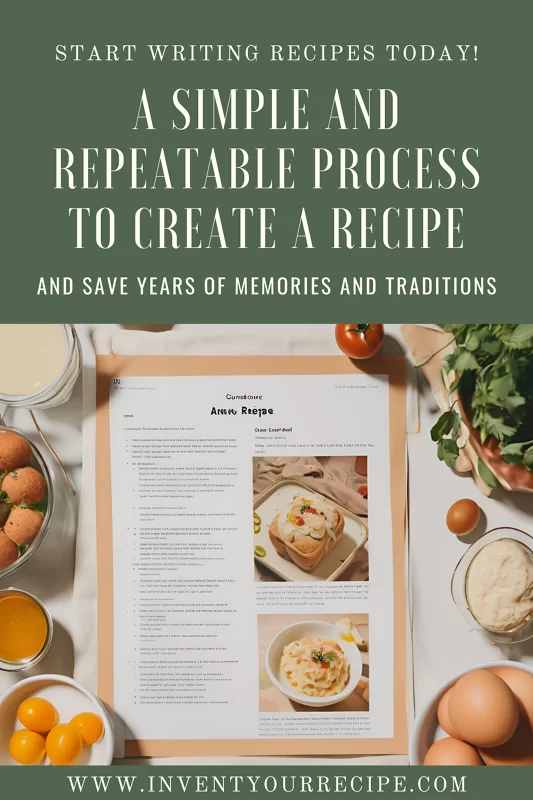
How to Invent Your Recipe While Enjoying the Process?
I love the way of cooking I have outline in the post. It reduces the overwhelm one might feel in the kitchen and produces a repeatable process to create endless recipes. The changes may be small, but your eating audience will not know that. They will just see new and delicious food in front of them time and time again!
A big part of cooking should be enjoying the process, food, and experience that it creates. A lot of my favorite memories revolve around cooking a recipe, or making dinner for my family, or cooking with my loved ones.
A big part of enjoying the process is doing what works for you and keeping things simple and efficient.
Embrace Your Style, But Try New Things
Cooking for me is a very manual process, I rely heavily on my hands. I like to touch and smell the food, sense the knife slicing through vegetables, feel the heaviness of a full skillet, and sweat from the heat of the stovetop. Because of this, a sharp chef’s knife, a cutting board, a hot skillet, and some small utensils allow me to cook most of the recipes I share on this blog.
I really enjoy the tactile nature of cooking. The repetitiveness of chopping, the reverberating sound of the knife hitting the cutting board, the sizzle of cold food hitting hot oil, the smell of garlic and onions sautéing. Just thinking about those things makes me very relaxed. It is my happy place.
On the flip side I know a lot of people enjoy using kitchen gadgets or trying the latest cooking apparatus. There is excitement in new things and with finding an easier way of doing something. Not to mention the time savings; in our busy day-to-day lives gadgets and appliances can make things easier and quicker. So, I say, to each is own.
But first, you need to identify your style. Is it your happy place? What makes you relaxed? Maybe gadgets and appliances are overwhelming to learn or use, or maybe they are just right for you. Experiment and try new things.
Although I have a default cooking style, I do use the occasional gadget or appliance. For instance, I like to use an air fryer for the convenience of heating up leftovers or making my kids a quick meal. I do not get much joy from using the air fryer, but I recognize the benefit and value of using it for specific cooking scenarios.
The big takeaway: embrace your cooking style but try new things. Lean into what you like to cook and how you like to cook it. Make it your default cooking style. But also see the benefit and value in trying new things. You might discover something you like, or a time-saving way of doing something. As I did after years of refusing to use an air fryer!
The Cookbook Is Here! Grab Your Copy
